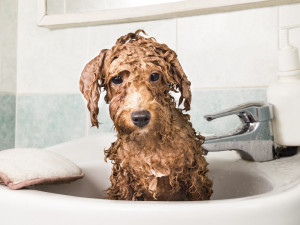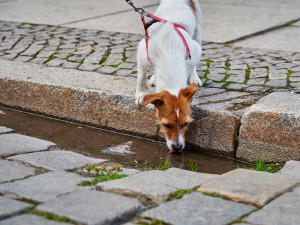Ringworm in Dogs: Recognizing Symptoms and Treatment of Canine Ringworm
Ringworm isn’t fun for anyone, but it is treatable — and preventable.

share article

Your pet wants you to read our newsletter. (Then give them a treat.)
To save you from a Google Image hellscape, let’s talk about what ringworm actually is before you start rogue searching. Ringworm is a fungal infection of the skin that can infect dogs, as well as many other species, including humans. The fungus is transmitted through contact with fungal spores that can travel from one animal to another, such as in a shelter environment or other pet care setting, where multiple dogs are living in a shared space. Spores can also be transmitted to toys, blankets, or other surfaces. In most cases, a dog will show signs of the infectionopens in a new tab within one to three weeks of an exposure.
You might suspect your pup has ringworm if you see circular areas of patchy hair loss with crusty or scabby spots on the skin. The dogs most likely to have ringworm include newly rescued dogs coming from life on the streets or shelters, as well as dogs who are very young, elderlyopens in a new tab, or immunocompromised. If your pup has these signs and fits the profile, you should see your vet right away to get a diagnosis. There are many other skin conditions that can look like ringworm and that dogs tend to get, so it is important to confirm the diagnosis with your vet before trying any treatments.
The good news is that this infection is mostly a nuisance and not a serious health concern. It requires a long course of treatment, as well as deep cleaning of your surroundings. If you’re unlucky enough to get ringworm from your pup, you’ll have to take medication, too. Most cases of ringworm will be cured with the right medications and do not cause any long-term problems.
What are the common symptoms of ringworm in dogs?
Ringworm can take on varied appearancesopens in a new tab in different dogs, so it can be tricky to diagnose it based on looks alone. Some of the more common signs include circular areas of hair loss, scaling, crusting, or scabbing of the skin, and/or redness of the skin. These changes in the skin are typically focused on the face, limbs, and tail, but can occur anywhere on the body. Dogs with ringworm can occasionally be itchy, but most dogs do not seem bothered by it at all. Some cases of ringworm can also affect the nails, creating brittle and crumbly toenailsopens in a new tab.
Don’t panic.
It is unusual for healthy adult dogs to contract ringworm if they are living in a stable home environment. This infection usually occurs when many dogs are living together, such as in animal shelters, or when they are strays with poor overall health and nutrition. Dogs with weakened immune systems are also at risk, such as very young, elderly, or immunosuppressed dogs — and dogs who already have ongoing skin disease.
In order to confirm the diagnosis, your vet will want to do some tests in addition to looking at their skin. This may include using a Wood’s Lamp, an ultraviolet light that illuminates common types of ringworm-causing fungus. In other cases, your vet may recommend taking a sample of the skin or fur and submitting it for a fungal culture or biopsy. These tests will confirm if your dog does, in fact, have ringworm and can also pinpoint which kind of fungus is to blame.
What are the treatment options for ringworm in dogs?
If your dog has ringworm, don’t panic. This is a very treatable condition and just requires some patience and persistence to clear it up. Most cases of ringworm are treated with a topical anti-fungal medication, which is applied to the skin, systemic antifungal drugs given by mouth, or both. The most effective strategy is to use both forms of antifungals in order to decontaminate the skin topically while also treating with an oral medication.
How do you prevent your dog from getting ringworm?
Most healthy dogs living in a home are not at high risk of contracting ringworm, although it can happen occasionally. Keeping your dog’s coat and nails in good health and keeping your living environment clean are good preventative strategies to practice. This includes regularly bathingopens in a new tab and brushing your dog to remove any contaminants from their fur, clipping their nailsopens in a new tab, and keeping them on monthly flea and tick preventatives.
These mini spa sessions are a good opportunity to take note of any changes with their skin or fur and schedule a visit with your vet if you notice anything out of the ordinary. Underlying skin problems, including allergiesopens in a new tab, fleasopens in a new tab, or bacterial infections, can all make the skin more vulnerable to secondary infections like ringworm, as can other health problems that affect their immune system. It is important to see your vet to treat these health problems before they snowball into bigger problems.
Keep your house clean.
When it comes to your house and living environment, there are a few important considerations to help prevent ringworm. It is important to maintain a good general cleaning routine, especially for fabric surfaces like dog bedsopens in a new tab, rugs, and carpets. Also, keep in mind the other pets who may be in the home or in contact with your pup. If you bring in a new pet, be sure to separate them from your pup initially to allow them to acclimate, as well as to prevent any infectious diseases from spreading between your pets.
Decontaminating and disinfectingopens in a new tab your environment is a very important part of treatment in order to prevent reinfection of your pup as well as to avoid spreading the infection to other family members, both human and pet. Remove fur from the environment daily by vacuuming and/or washing all fabrics. Any materials that cannot be thoroughly disinfected should be removed from the home. Disinfect hard surfaces at least twice a week using appropriate cleaning solutions such as dilute bleach or Trifectant. Be sure to clean all carpets and furniture well, too.
Keep a close eye on your pup.
Make sure to have any health concerns checked out and treated by a vet before introducing your new pet to other housemates. Also, wash your hands thoroughly after playing with any other animals and before petting your pup. If your dog tends to dig in the dirt and/or explore heavily wooded areas, be sure to bathe and brush your pup after these adventures. Some fungal spores are found in the soil, so you will want to prevent your dog from bringing those into your home. This is also a good opportunity to check your pup for ticksopens in a new tab and other hitchhikers.
If you have symptoms, talk to a doctor right away.
Because ringworm is a zoonotic disease, meaning it can be transmitted from animals to people, make sure to mention any health concerns you have to your doctor and seek treatment if you have any suspicious changes to your skin. You can protect yourself from infection by washing your hands frequently, wearing gloves, and washing your clothes after contact with a ringworm-infected pup, but this is not always foolproof. In most cases, this is a very curable condition in people as well, but anyone with underlying health problems or who is immunosuppressed should avoid contact with infected animals and people.
No one wants to get ringworm, and it will certainly add a whole bunch of steps to your daily routine, but this is really just a huge pain in the butt and not a serious health concern for most pups. It can be intimidating to deal with a ringworm outbreak, especially if it comes from your newly adopted puppy and you are feeling overwhelmed by pet ownership. Rest assured, you will get through it after a few tedious weeks, your house will be cleaner than ever, and all those extra baths will make for adorable photos and valuable bonding time.

Dr. Amy Fox, DVM
Amy Fox, DVM is a small animal veterinarian in New York City. A lifelong animal lover, Dr. Fox studied biology in college and then worked as a veterinary nurse before pursuing veterinary school at Cornell University. She has worked in many different settings including shelter medicine, emergency medicine, general practice, and animal cruelty and forensics. She is especially interested in nutrition, preventative medicine and care for senior pets. Dr. Fox also enjoys writing about veterinary medicine and teaching. In her free time she loves to cook, garden, and go for long runs.
Related articles
![Dog drinking water from a puddle in the road]() opens in a new tab
opens in a new tabGiardia in Dogs: Signs, Symptoms and Treatment of This Parasite
If your dog drinks from puddles or splashes around in lakes, read this.
![Woman holding a beagle in warm dappled summer light]() opens in a new tab
opens in a new tabYou’ve Got a Summer-Lovin’ Pup. Here’s How to Keep Them Safe
Some like it hot (but not most dogs). Here are the season’s health hazards, from fleas to foxtails.
![A dog scratching itself among the leaves outside.]() opens in a new tab
opens in a new tabImmunotherapy Can Be the Solve For Your Dog’s Allergies
If allergens were to ask, “Am I the drama?,” the answer would be yes.
![a Chihuahua dog licking their paw]() opens in a new tab
opens in a new tabWhy Is Your Dog Obsessed With Licking Their Paws?
Their toes might smell like Fritos, but there’s no way they taste that good.
![Cute weimaraner dog lying on lawn and scratching its back]() opens in a new tab
opens in a new tab5 of the Best Ways to Solve Your Dog’s Allergies
Here’s what works (and what doesn’t).
![A dog poses with Floof dog grooming products and a dollop of shampoo on their nose]() opens in a new tab
opens in a new tabFloof Takes a Gentle Approach to Your Itchy Dog’s Skincare
Mark your pups’ self-care calendars: The company’s eco-friendly, allergy-friendly products are launching July 17.












